#Seven US Companies Collaborate with NASA to Advance Space Capabilities
Explore tagged Tumblr posts
Text
Seven US Companies Collaborate with NASA to Advance Space Capabilities
NASA will partner with seven U.S. companies to meet future business and government needs, ultimately benefitting human spaceflight and the U.S. commercial low Earth orbit economy. from NASA https://ift.tt/bchj6O9
0 notes
Text
Starliner Launch: Paving the Way for a New Era in Space Travel
Overview The launch of Starliner represents a critical turning point in the development of more regular and affordable space travel. The Starliner spaceship, created by Boeing, will launch a new chapter in human space exploration by carrying astronauts to the International Space Station (ISS) and beyond.
Context of the Starliner Program's Development
When NASA issued a request for commercial spacecraft that could transport people to the International Space Station, the Starliner program was launched. In order to lessen dependency on Russian Soyuz rockets and promote a competitive space industry in the US, Boeing was given a contract under NASA's Commercial Crew Program to create this new spaceship.
Objectives and Goals
Getting crew members to and from the International Space Station (ISS) in a secure, dependable, and economical manner is the main objective of the Starliner program. This involves not just moving humans but also assisting with technology development and research that will open the door for upcoming deep space missions, including as trips to the Moon and Mars.
Collaboration with NASA The Program for Commercial Crew
One important project from NASA is the Commercial Crew Program, which aims to collaborate with commercial businesses to create and run crewed spaceflight services. The objectives of this program are to guarantee that the United States stays at the forefront of space exploration while also encouraging the private sector and cutting expenses.
Details of the Collaboration
The Starliner's development has been greatly aided by Boeing and NASA's partnership. Assuring that the spacecraft satisfies the highest standards of performance and reliability requires a cooperation that includes stringent testing, safety evaluations, and integration of NASA's requirements.
Technical Details, Architecture, and Features
Reusable spacecraft, the Starliner can accommodate up to seven people or a combination of crew and cargo. Advanced avionics, reliable life support systems, and a launch abort system to guarantee crew safety in an emergency are among the important elements. The spacecraft's smooth re-entry design and ability to land on solid ground with airbags and parachutes improve recovery and turnaround times.
Innovations and Safety Procedures
A primary priority for the Starliner program is safety. The spacecraft has significant shielding to protect against space debris, redundant systems to handle probable malfunctions, and automated docking capabilities to lower the chance of human error. Thanks to these advances, safety regulations are not just met, but exceeded by the Starliner.
Also Read :-
Same-Day Train Tour to Agra from Delhi with a Private Tour Guide Company in India
With the Same-Day Train Tour to Agra from Delhi provided by Private Tour Guide India Company, you can take in the timeless grandeur of the Taj Mahal and the rich cultural legacy of Agra. With the help of this well thought-out itinerary, you may go to Agra, take in its famous sites, and then return to Delhi in the same day.
Overview Agra is a historical and culturally rich city that is home to the majestic Taj Mahal. Discover the finest of Agra's legacy in a comfortable and convenient manner with the Same Day Agra Tour by Train from Delhi. You may make the most of your time in this historic city with the flawless and fascinating travel experience provided by Private Tour Guide India Company.
Highlights of the Tour Train travel from Delhi to Agra and return was comfortable. See the Agra Fort, the Taj Mahal, and other historical places. excursions led by professionals that offer in-depth knowledge of Agra's culture and history. Easy travel planning and individualised attention. Route Early in the morning: Leaving the Delhi Hotel Transportation to the Train Station You get picked up early in the morning from your Delhi hotel to start your day. You will be escorted to the railway station by our experienced driver, where you will catch the train to Agra.
Travel by Train to Agra Take the express train to Agra for a relaxing and beautiful travel. You may unwind and take in the scenery while you cruise toward your destination because breakfast will be provided onboard.
Mid-Afternoon: Reaching Agra Greetings and Overview Our knowledgeable local guide will meet you when you arrive in Agra, give you a rundown of the day's events, and stay with you the entire time.
Late in the morning: The Taj Mahal Visit the Taj Mahal on a Guided Tour. The famous Taj Mahal, a UNESCO World Heritage Site and a representation of unending love, is the first place you visit. Take a guided tour of this architectural wonder to discover more about its significance, history, and fine craftsmanship.
Lunch and Agra Fort in the afternoon Investigating Agra Fort See the magnificent Agra Fort next, which is also a UNESCO World Heritage Site. While your guide tells intriguing tales about its Mughal architecture and historical significance, explore the palaces, rooms, and gardens.
During lunch Stop for lunch at a nearby eatery to refuel for the remainder of your tour while enjoying delicious, authentic Indian food.
Mehtab Bagh, mid-afternoon Exploration of Mehtab Bagh Visit Mehtab Bagh, a stunning garden across the Yamuna River from the Taj Mahal, after lunch. From this vantage point, take in breathtaking views of the Taj Mahal and make sure to take some unforgettable pictures of the structure.
Evening: Go back to Delhi Leave of Agra You will be taken to the Agra railway station at the conclusion of the day so that you can catch the train back to Delhi.
Train Travel to Delhi As you take in the amazing sights and experiences of the day, unwind and enjoy the relaxing train ride back to Delhi.
Arrival in Delhi Your amazing Same Day Agra Tour will come to an end when you are dropped off at your hotel in Delhi after being picked up from the train station.
Why Select India's Private Tour Guide Company? Professional Handbooks Our experienced guides ensure an enlightening and enriching trip by offering in-depth insights into Agra's history, culture, and architecture.
Comfortable Journeying For hassle-free and pleasurable tours, we provide clean, air-conditioned cars for hotel transfers and cozy train rides.
Tailored Support We customize our trips to fit your interests and requirements, offering great service and individualized attention to make sure you have an amazing time.
Flowing Logistics To provide a seamless and pleasurable tour experience, we take care of all the arrangements, from hotel pickup to drop-off and all points in between.
In summary Discover the magnificence of the Taj Mahal and the rich history of Agra in a single day with the Same Day Agra Tour by Train from Delhi by Private Tour Guide India Company. This tour offers an amazing experience with comfortable rail travel, knowledgeable tour guides, and efficient logistics. Make your tour reservation right now to start a journey that will leave you with priceless memories.
0 notes
Text
0 notes
Text
Rocket Lab shifts CAPSTONE launch to New Zealand
https://sciencespies.com/space/rocket-lab-shifts-capstone-launch-to-new-zealand/
Rocket Lab shifts CAPSTONE launch to New Zealand

WASHINGTON — A NASA smallsat mission to test the orbit that will be used by the lunar Gateway will launch from New Zealand and not Virginia as originally planned.
Rocket Lab announced Aug. 6 that it will launch the Cislunar Autonomous Positioning System Technology Operations and Navigation Experiment (CAPSTONE) mission on an Electron rocket from its Launch Complex 1 in New Zealand in the fourth quarter. When Rocket Lab won the NASA contract to launch CAPSTONE in February 2020, it planned to launch the mission from its Launch Complex 2 at Wallops Island, Virginia.
In its statement, Rocket Lab didn’t explain the change in launch sites. “Flexible isn’t a word usually used to describe lunar missions but operating two launch complexes gives us the freedom to select a site that best meets mission requirements and schedule,” said Peter Beck, chief executive of Rocket Lab.
However, CAPSTONE would be the second Rocket Lab mission in recent weeks that shifted from Virginia to New Zealand. The most recent Electron launch July 26 placed into orbit Monolith, a smallsat developed by the Air Force Research Laboratory. Monolith was originally going to launch on the first Electron mission from Virginia.
Rocket Lab said at the time that it shifted the launch of Monolith because of ongoing work by NASA to certify the software for the rocket’s autonomous flight termination system. A NASA spokesman said in July that the agency expected to complete certification of the unit by the end of the year.
The Electron will be carrying CAPSTONE, a 25-kilogram smallsat developed by Colorado-based Advanced Space, attached to a Photon spacecraft. Photon will use its HyperCurie engine to place CAPSTONE on a trajectory to the moon, separating about seven days after launch. CAPSTONE will then use its own hydrazine propulsion system to maneuver into a near-rectilinear halo orbit around the moon, the same orbit that will be used by the lunar Gateway.
NASA will use CAPSTONE to test the stability of the orbit, verifying models for propulsion needed to maintain the orbit. CAPSTONE will also test a space-craft-to-spacecraft navigation technology.
Development of CAPSTONE remains on schedule. Advanced Space said in an Aug. 2 statement that they completed the second in a series of operations readiness tests, real-time simulations of mission operations.
“This comprehensive readiness test illustrates the capabilities of our team to focus on mission execution in challenging environments,” Brad Cheetham, chief executive of Advanced Space, said in the company statement. “This mission really showcases the benefits of collaboration between NASA and industry.”
#Space
0 notes
Text
Space Missions Come Together in Colorado
Our leadership hit the road to visit our commercial partners Lockheed Martin, Sierra Nevada Corp. and Ball Aerospace in Colorado. They were able to check the status of flight hardware, mission operations and even test virtual reality simulations that help these companies build spacecraft parts.
Let’s take a look at all the cool technology they got to see…
Lockheed Martin
Lockheed Martin is the prime contractor building our Orion crew vehicle, the only spacecraft designed to take humans into deep space farther than they’ve ever gone before.
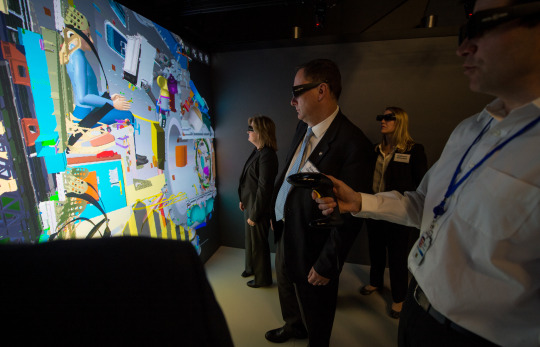
Acting NASA Deputy Administrator Lesa Roe and Acting NASA Administrator Robert Lightfoot are seen inside the CHIL…the Collaborative Human Immersive Laboratory at Lockheed Martin Space Systems in Littleton, Colo. Lockheed Martin’s CHIL enables collaboration between spacecraft design and manufacturing teams before physically producing hardware.
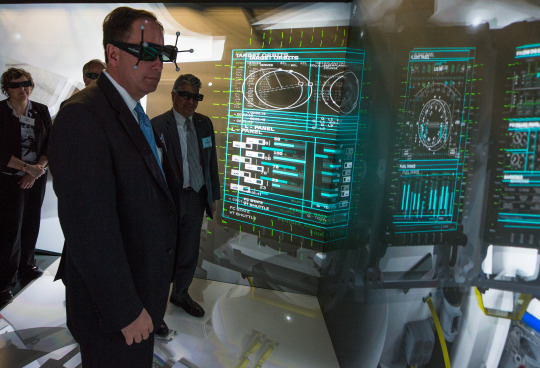
Cool shades! The ability to visualize engineering designs in virtual reality offers tremendous savings in time and money compared to using physical prototypes. Technicians can practice how to assemble and install components, the shop floor can validate tooling and work platform designs, and engineers can visualize performance characteristics like thermal, stress and aerodynamics, just like they are looking at the real thing.
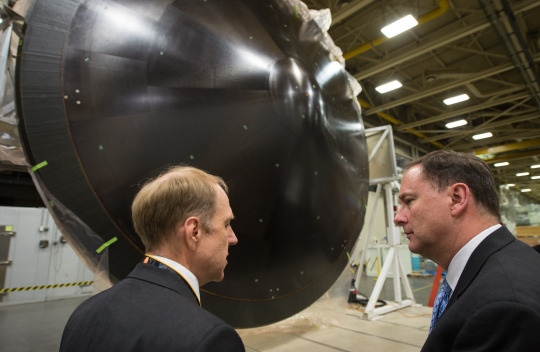
This heat shield, which was used as a test article for the Mars Curiosity Rover, will now be used as the flight heat shield for the Mars 2020 rover mission.
Fun fact: Lockheed Martin has built every Mars heat shield and aeroshell for us since the Viking missions in 1976.
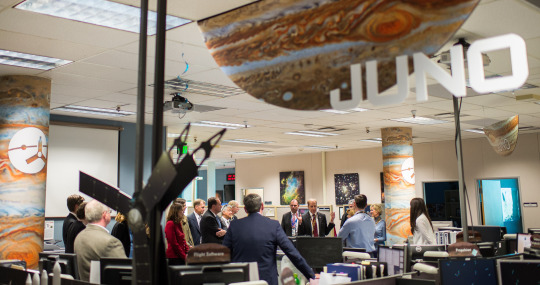
Here you can see Lockheed Martin’s Mission Support Area. Engineers in this room support six of our robotic planetary spacecraft: Mars Odyssey, Mars Reconnaissance Orbiter, MAVEN, Juno, OSIRIS-REx and Spitzer, which recently revealed the first known system of seven Earth-size planets around a single star, TRAPPIST-1. They work with NASA centers and the mission science teams to develop and send commands and monitor the health of the spacecraft.
See all the pictures from the Lockheed Martin visit HERE.
Sierra Nevada Corporation
Next, Lightfoot and Roe went to Sierra Nevada Corporation in Louisville, Colo. to get an update about its Dream Chaser vehicle. This spacecraft will take cargo to and from the International Space Station as part of our commercial cargo program.
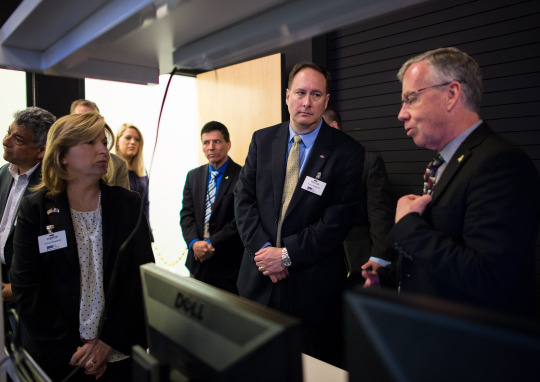
Here, Sierra Nevada Corporation’s Vice President of Space Exploration Systems Steve Lindsey (who is also a former test pilot and astronaut!) speaks with Lightfoot and Roe about the Dream Chaser Space System simulator.
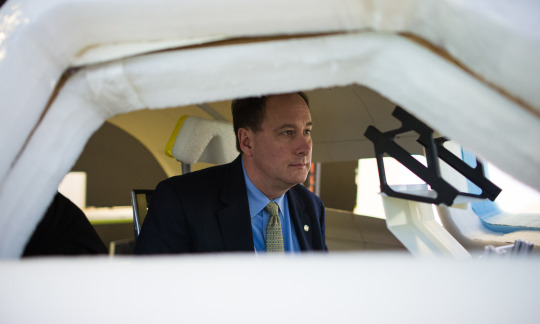
Lightfoot climbed inside the Dream Chaser simulator where he “flew” the crew version of the spacecraft to a safe landing. This mock-up facility enables approach-and-landing simulations as well as other real-life situations.
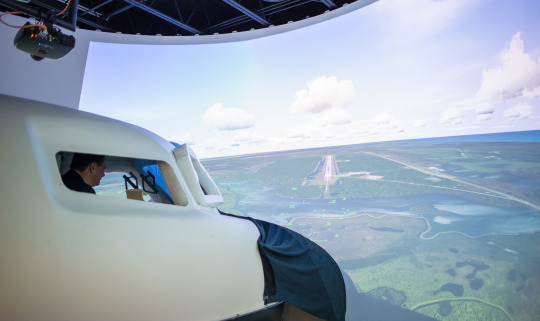
See all the images from the Sierra Nevada visit HERE.
Ball Aerospace
Lightfoot and Roe went over to Ball Aerospace to tour its facility. Ball is another one of our commercial aerospace partners and helps builds instruments that are on NASA spacecraft throughout the universe, including the Hubble Space Telescope and the New Horizons mission to Pluto. Ball designed and built the advanced optical technology and lightweight mirror system that will enable the James Webb Space Telescope to look 13.5 billion years back in time.
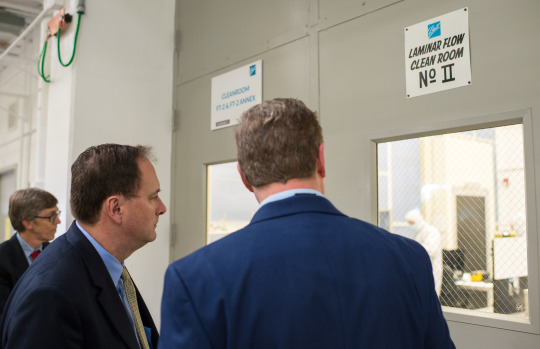
Looking into the clean room at Ball Aerospace’s facility in Boulder, Colo., the team can see the Ozone Mapping Profiler Suite. These sensors are used on spacecraft to track ozone measurements.
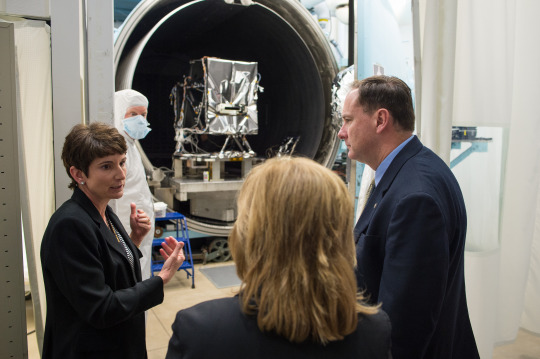
Here, the group stands in front of a thermal vacuum chamber used to test satellite optics. The Operation Land Imager-2 is being built for Landsat 9, a collaboration between NASA and the U.S. Geological Survey that will continue the Landsat Program’s 40-year data record monitoring the Earth’s landscapes from space.
See all the pictures from the Ball Aerospace visit HERE.
We recently marked a decade since a new era began in commercial spaceflight development for low-Earth orbit transportation. We inked agreements in 2006 to develop rockets and spacecraft capable of carrying cargo such as experiments and supplies to and from the International Space Station. Learn more about commercial space HERE.
Make sure to follow us on Tumblr for your regular dose of space: http://nasa.tumblr.com
#nasa#space#technology#science#commercialpartners#commercialspace#ballaerospace#lockheedmartin#sierranevada#spacecraft#missions
827 notes
·
View notes
Text
Will Rio Be a 'Smarter' City After the Olympic Games?
The city installed expensive new technology for the event, but a recent study finds the investment might not pay off in the long run.
Published in CityLab.com
Brazilians have had a lot to worry about in the lead-up to the Olympic Games this month: a political crisis that led to the impeachment of President Dilma Rousseff, a public health crisis in the form of the Zika virus, an increased violent police presence in the streets, and a series of failed public works projects meant to showcase the city’s progress during the games. But there’s a different problem that should be equally worrisome: What’s going to happen to the city when the games have finished and Rio returns to normal life?
Official wisdom has held that the Olympics and other megaevents leave a trail of benefits for host cities in their wake, but urbanists have been increasingly questioning that idea. In Rio’s case (for both the 2012 World Cup and this year’s games), one of the benefits was supposed to be the increased use of technology to manage the city, developed in part to help organize these large events. Rio, it was said, would emerge from the World Cup and the Games at the vanguard of “smart cities” in the region.
But a recent study, published in the Journal of Urban Technology in April, questions the work that Rio has done to transform itself into a smart city. Researchers Christopher Gaffney and Cerianne Robertson analyzed two key parts of Rio’s smart-city infrastructure, both of which form part of the legacy of these megaevents: the Integrated Command and Control Center (CICC) and the Rio Operations Center (COR), which cost the city a combined $40 million.
“As part of Brazil’s World Cup contractual obligations to FIFA, the federal government developed two Integrated Centers of Command and Control (CICC)—one in Brasilia and one in Rio de Janeiro…,” reads the study. “These installations were frequently cited as the major legacy of the World Cup in Dilma Rousseff’s successful 2014 presidential campaign.”
The CICC is a monitoring center where different police units (military, civil, transit, and federal), firefighters, paramedics, the Municipal Guard, and civil defense units can all coordinate with one another. All emergency calls are received at this center, and it organizes security operations and the controversial “pacification program” in the city’s favelas. Ninety-eight LED screens mounted in the room connect to 500 closed-circuit cameras placed in different parts of the city.
But Gaffney’s observations throw the whole operation of the CICC (and of COR, which monitors citizen safety, transit and climate) into question. “When you enter into these places, everything feels like a movie set,” Gaffney tells CityLab. “The employees have these robes like they work at NASA, and it feels like they’re acting out this ritual of intelligence. It gives the impression of being sophisticated and technologically advanced, but it’s all part of a performance.”
Until now, the “performance” Gaffney refers to has been generally well-received by authorities on smart cities. In the years between the World Cup and the Olympics, the monitoring systems being developed in Rio were of great interest to political leaders and media outlets including CNN and The New York Times. The city was designated the “best smart city of 2013,” and Mayor Eduardo Paes did a popular TED Talk on Rio’s new approach to city management.
“We do practice simulations for every large event. We have 500 professionals working 24 hours a day, seven days a week,” explained Clara Schreiner at a recent Inter-American Development Bank conference on smart cities. “We have strong integration with other federal and state agencies. All [important] information is collected by the Rio Operations Center.” Schreiner is a representative for one of the private companies collaborating with the government on these large centers.
Despite assurances, the study authors criticize the value of the work these centers do—and the claim that they help the city of Rio as a whole.
An Unequal Intelligence
One of the main problems Gaffney has with the use of smart-city technology in Rio is that, according to him, its use always ends up being unequal. That is to say, there’s a “smart Rio” and a “not-so smart Rio,” and where a neighborhood falls in this binary depends, in large part, on its purchasing power.
“Because we’re talking about a very fragmented city, and a very unequal city in terms of resources and wealth concentration, the cameras and data-evaluation agencies are mainly located in rich areas,” says Gaffney. “Transit is highly monitored, but there’s heavy emphasis on automobiles, which only the rich have. It’s a system that tends to reaffirm the inequalities that already exist.”
It’s the same in terms of security, where affluent zones tend to be monitored more carefully, says Gaffney. It even shows up in the monitoring of potential natural disasters: One of the functions of Rio’s smart-city system is that, in theory, it uses sirens to alert citizens about potential mudslides in the wake of flooding. “But recently, the company that manages these alarms didn’t get its check from the government, and now the sirens are silent,” says Gaffney.
The study also criticized the management of information collected by the CICC and COR. At the CICC, all collected data is erased after 90 days. “The volume of information that’s collected isn’t clear, and neither is the way it’s processed,” explains Gaffney. “Having more data is not necessarily good. The important thing is how it’s used, how it’s accessed, and what policies are coming out if it.”
The researchers also criticize the use of these systems to quash protests, which could occur during the Olympic Games. “This just increases the skewed nature of confrontations between police and protesters. If you have 400 cameras near a stadium, the police can easily drag protesters away, cut off cell signals, and close the streets, while the officers communicate by radio,” Gaffney says.
According to the authors, this is exactly the opposite of what a smart city is supposed to accomplish. The system is supposed to function to increase participation in the community, not punish people for it. But for now, all the efforts of Rio’s smart-city technology are focused on security (and transit, especially managing congestion).
Because of all of this, Gaffney is pessimistic about the legacy of megaevents in making Rio a smarter city. “The paradigm of smart cities isn’t capable of addressing the most pressing needs of cities with chronic deficits in urban infrastructure and an absence of robust civil-society institutions,” the study concludes. “As such, smart-city systems may actually contribute to the securitization and fragmentation of urban space, exacerbating socioeconomic and political divides.”
0 notes
Text
DR. MAE JEMISON TO LAUNCH LOOK UP AT 25TH ANNIVERSARY OF SPACEFLIGHT CELEBRATION

FOR IMMEDIATE RELEASE
New Initiative to Connect and Inspire People Globally over the Year Culminating in a Day to LOOK UP Global Special Event
LOS ANGELES, September 15, 2017 – Tonight, Dr. Mae Jemison the world’s first woman of color in space will oversee the launch of the LOOK UP worldwide initiative during the celebration of the 25th anniversary of her spaceflight in 1992.
LOOK UP over the next year will connect people worldwide, from all walks of life, culminating on a single day in August 2018 when everyone will be asked to LOOK UP and share what they see and their thoughts, hopes, fears, dreams and ideas for best path forward. LOOK UP is a day, 24 hours, we acknowledge our oneness as Earthlings and concurrently our right to be a part of this greater universe.
Why LOOK UP? “It is critical that we realize that worldwide, that all our lives and well-being are inextricably woven into the fabric of this planet Earth and globally connected to the greater universe,” Jemison stated. “This is not a choice; it is a reality. Whether we as a species survive, progress and thrive depends upon how we embrace this reality.”
Notables signing onto the goals of LOOK UP with Jemison, an engineer, physician, social scientist and NASA’s first African American woman astronaut, include: LeVar Burton; Nichelle Nichols; Jill Tarter, Ph.D.; Halfu Osumare, Ph.D.; Amy Millman and Springboard Enterprises; MAKERS; Bayer Corporation; Scholastic, Inc.; 100 Year Starship; and, Yuri’s Night.
LOOK UP is purposefully designed to build momentum and evolve as individuals and organizations around the globe are connected, propose and develop LOOK UP activities in schools, workplaces, communities and nations that will highlight what they learn from the sky. The LOOK UP platform will facilitate these activities and the creation of a tapestry of the images, observations and activities that are woven together and can be accessed globally. The LOOK UP website, www.lookuponesky.org will “go live” tonight and individuals and groups are urged to sign up to receive updates, challenges, opportunities and news, as well as to become part of the LOOK UP global community.
Dr. Jill Tarter points to the fascination of the recent solar eclipse that swept North America and reminds us that “For millennia, across the world humans have looked to the sky to navigate their world. We live both under one sky here on Earth and within the greater universe. And while part of Earth, it is important to push to explore farther and to claim a place in the larger cosmos.”
Jemison and colleagues from 100 Year Starship have been developing LOOK UP for over a year and believe it is critical in the world today to offer this platform to engage people across cultures, nations and economies in order to facilitate understanding and contributing to our shared future. To LOOK UP and build a better, robust path forward that includes and benefits us all.
LeVar Burton explains LOOK UP, “Let’s take one day to LOOK UP and recognize that we share not just the same origins, but the same sky. And a growing ambition to be mature enough to leave home. LOOK UP and join the movement.”
ABOUT MAE JEMISON, M.D.
Audacious and pioneering, polymath Dr. Mae Jemison is a leading voice for science, social responsibility and innovation. Jemison leads 100 Year Starship®, a global initiative that is pushing the frontiers of space exploration – ensuring human interstellar travel in 100 years. The world’s first woman of color in space, she is committed to applying advance space technology to enhance life on Earth. Dr. Jemison draws upon her experience as a physician, inventor, environmental studies professor, science literacy advocate, development worker in Africa and founder of two tech start-ups. Recently, LEGO announced her as one of five Women of LEGO NASA kit. She is the 2016-2017 Poling Chair at Indiana University’s Kelley School of Business. A member of Fortune 500 boards, the National Academy of Medicine and the National Women’s Hall of Fame, Dr. Jemison was voted one of the top seven women leaders in a presidential ballot straw poll and was the first astronaut to appear on Star Trek. Dr. Jemison lives in Houston and is still learning important life lessons from her cats.
For more information, visit www.drmae.com.
Find Dr. Jemison on social media:
Twitter: @maejemison
ABOUT 100 YEAR STARSHIP™
100 Year Starship™ (100YSS) is building a global community to ensure that the capabilities for human interstellar travel beyond our solar system exist as soon as possible, and definitely within the next 100 years. An independent, non-governmental, long-term initiative, 100YSS was started in 2012 with seed-funding through a competitive grant from DARPA (Defense Advanced Research Projects Agency) to foster the type of explosive innovation and technology and social advances born from addressing such an audacious challenge. To bolster such innovation, 100YSS has programs and projects include research and innovation, across the physical and social sciences, the arts, entrepreneurship and education. Based in Houston, 100YSS collaborates with international organizations, companies, universities and individuals including affiliate in Brussels, partnerships in Africa and Asia.
For more information, visit www.100yss.org.
Find us on social media:
Facebook: www.facebook.com/100YearStarship
Twitter: @100YSS
0 notes
Text
DR. MAE JEMISON TO LAUNCH LOOK UP AT 25TH ANNIVERSARY OF SPACEFLIGHT CELEBRATION

FOR IMMEDIATE RELEASE
CONTACT:
Cindy Carway/Stephanie Hornback
Carway Communications, Inc.
212-378-2020/[email protected]
DR. MAE JEMISON TO LAUNCH LOOK UP AT 25TH ANNIVERSARY OF SPACEFLIGHT CELEBRATION
New Initiative to Connect and Inspire People Globally over the Year Culminating in a Day to LOOK UP Global Special Event
LOS ANGELES, September 15, 2017 – Tonight, Dr. Mae Jemison the world’s first woman of color in space will oversee the launch of the LOOK UP worldwide initiative during the celebration of the 25th anniversary of her spaceflight in 1992.
LOOK UP over the next year will connect people worldwide, from all walks of life, culminating on a single day in August 2018 when everyone will be asked to LOOK UP and share what they see and their thoughts, hopes, fears, dreams and ideas for best path forward. LOOK UP is a day, 24 hours, we acknowledge our oneness as Earthlings and concurrently our right to be a part of this greater universe.
Why LOOK UP? “It is critical that we realize that worldwide, that all our lives and well-being are inextricably woven into the fabric of this planet Earth and globally connected to the greater universe,” Jemison stated. “This is not a choice; it is a reality. Whether we as a species survive, progress and thrive depends upon how we embrace this reality.”
Notables signing onto the goals of LOOK UP with Jemison, an engineer, physician, social scientist and NASA’s first African American woman astronaut, include: LeVar Burton; Nichelle Nichols; Jill Tarter, Ph.D.; Halfu Osumare, Ph.D.; Amy Millman and Springboard Enterprises; MAKERS; Bayer Corporation; Scholastic, Inc.; 100 Year Starship; and, Yuri’s Night.
LOOK UP is purposefully designed to build momentum and evolve as individuals and organizations around the globe are connected, propose and develop LOOK UP activities in schools, workplaces, communities and nations that will highlight what they learn from the sky. The LOOK UP platform will facilitate these activities and the creation of a tapestry of the images, observations and activities that are woven together and can be accessed globally. The LOOK UP website, www.lookuponesky.org will “go live” tonight and individuals and groups are urged to sign up to receive updates, challenges, opportunities and news, as well as to become part of the LOOK UP global community.
Dr. Jill Tarter points to the fascination of the recent solar eclipse that swept North America and reminds us that “For millennia, across the world humans have looked to the sky to navigate their world. We live both under one sky here on Earth and within the greater universe. And while part of Earth, it is important to push to explore farther and to claim a place in the larger cosmos.”
Jemison and colleagues from 100 Year Starship have been developing LOOK UP for over a year and believe it is critical in the world today to offer this platform to engage people across cultures, nations and economies in order to facilitate understanding and contributing to our shared future. To LOOK UP and build a better, robust path forward that includes and benefits us all.
LeVar Burton explains LOOK UP, “Let’s take one day to LOOK UP and recognize that we share not just the same origins, but the same sky. And a growing ambition to be mature enough to leave home. LOOK UP and join the movement.”
For more information visit: lookuponesky.org
ABOUT MAE JEMISON, M.D.
Audacious and pioneering, polymath Dr. Mae Jemison is a leading voice for science, social responsibility and innovation. Jemison leads 100 Year Starship®, a global initiative that is pushing the frontiers of space exploration – ensuring human interstellar travel in 100 years. The world’s first woman of color in space, she is committed to applying advance space technology to enhance life on Earth. Dr. Jemison draws upon her experience as a physician, inventor, environmental studies professor, science literacy advocate, development worker in Africa and founder of two tech start-ups. Recently, LEGO announced her as one of five Women of LEGO NASA kit. She is the 2016-2017 Poling Chair at Indiana University’s Kelley School of Business. A member of Fortune 500 boards, the National Academy of Medicine and the National Women’s Hall of Fame, Dr. Jemison was voted one of the top seven women leaders in a presidential ballot straw poll and was the first astronaut to appear on Star Trek. Dr. Jemison lives in Houston and is still learning important life lessons from her cats.
For more information, visit www.drmae.com.
Find Dr. Jemison on social media:
Twitter: @maejemison
ABOUT 100 YEAR STARSHIP™
100 Year Starship™ (100YSS) is building a global community to ensure that the capabilities for human interstellar travel beyond our solar system exist as soon as possible, and definitely within the next 100 years. An independent, non-governmental, long-term initiative, 100YSS was started in 2012 with seed-funding through a competitive grant from DARPA (Defense Advanced Research Projects Agency) to foster the type of explosive innovation and technology and social advances born from addressing such an audacious challenge. To bolster such innovation, 100YSS has programs and projects include research and innovation, across the physical and social sciences, the arts, entrepreneurship and education. Based in Houston, 100YSS collaborates with international organizations, companies, universities and individuals including affiliate in Brussels, partnerships in Africa and Asia.
For more information, visit www.100yss.org.
Find us on social media:
Facebook: www.facebook.com/100YearStarship
Twitter: @100YSS
0 notes